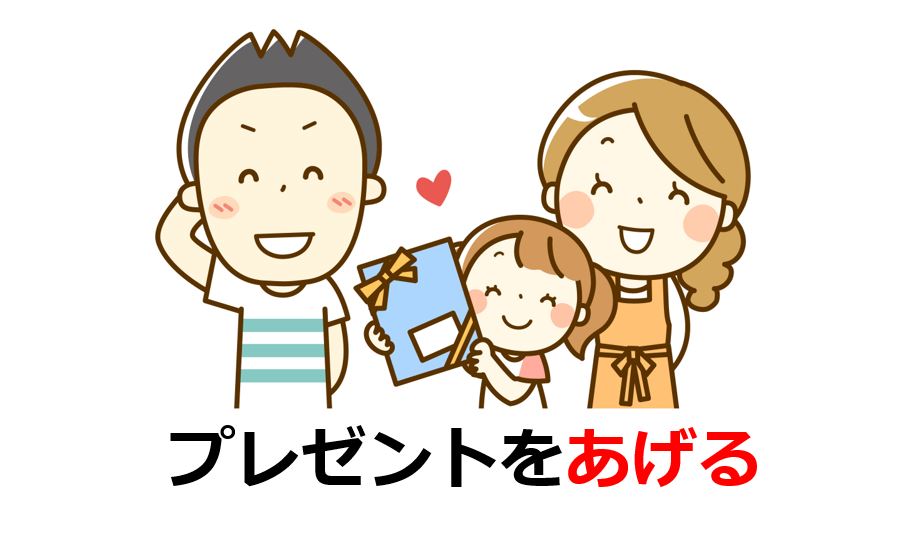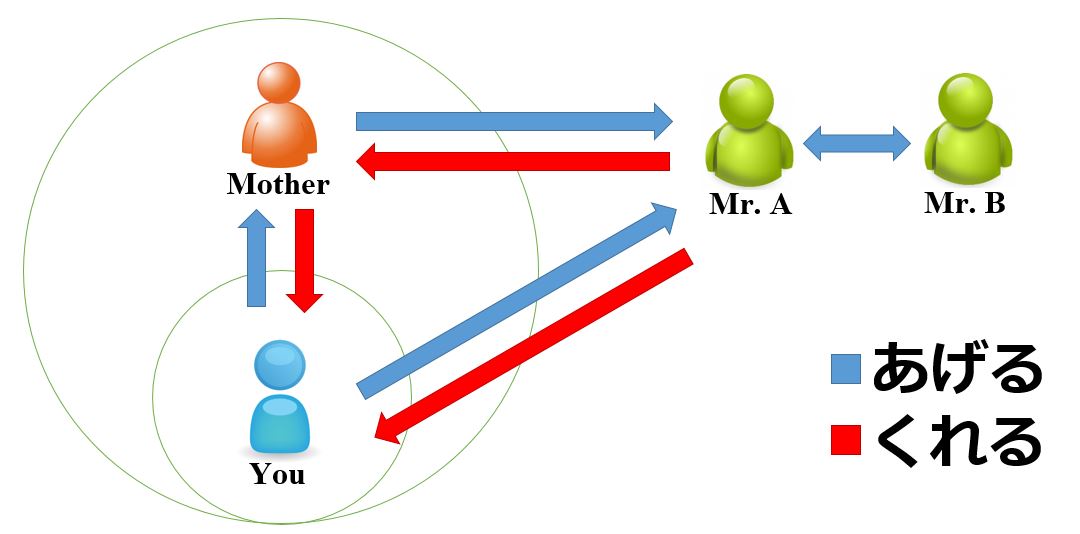How To Say To Change In Japanese

Last time, you lot learned how the causative form works like 子 供 に勉 強 をさせる ([I] volition make my child study). In passive and causative sentences, you lot have to pay attention to people'south positions such as doers and direction-givers. In this lesson, you will tackle one of the concepts unique to Japanese: receiving and giving. This is likewise involved with people's positions.
How to Limited Giving and Receiving by Using あげる, くれる, and もらう
First of all, we must say this topic is related to Japanese civilization. Yous have to understand the concept of our social community prior to the grammatical rule. Both あげる and くれる mean "to give" in English language, only y'all have to choose the proper one depending on contexts.

Permit's accept a family every bit an example for a social customs. In the chart above, a circle represents a community. Yous are an contained person and thus you accept your ain circle. You and your female parent are a member of your family and thus y'all and she share the big circle. In Japanese, you have to alter the wording based on the circles. When someone gives something from the inside to the outside, you lot take to use あげる. That is to say, you use あげる when y'all (*from your circle) give something to your mother, and when your female parent (from your family circumvolve) gives something to Mr. A. What if someone gives something from the outside to the within? This is where くれる comes into play. You lot use くれる when Mr. A (*from the outside of your family circumvolve) gives something to your mother, and your mother (from the exterior of your own circle) gives something to you. As for betwixt Mr. A and Mr. B, you always utilize あげる. The wording will thing only when circles y'all belong to is involved with transactions. Now, let's move onto the judgement construction.
あげる, くれる, and もらう as Verbs
| [私 は / が] | ノートを | お母 さんに | あげる / あげます |
| [Topic / Subject] | Direct Object | Target | Verb |
| [I] will requite my mother a notebook. | |||
Dissimilar the cultural concept, the grammar is very uncomplicated. Yous just use the particle を and the particle に. Hither are more examples.
| お母 さんはノートをAさんに(あげた / あげました)。 My mother gave Mr. A a notebook. |
| AさんはノートをBさんに(あげた / あげました)。 Mr. A gave Mr. B a notebook. |
| Aさんはノートをお母 さんに(くれた / くれました)。 Mr. A gave my mother a notebook. |
| お母 さんはノートを私 に(くれた / くれました)。 My mother gave me a notebook. |
あげる and くれる are used on the premise that recipients volition feel happy by means of giving something. Thus, if transactions may not issue in any happiness, you cannot utilise them.
| 先生 が宿 題 をたくさん 出 した ・くれた。 The teacher gave [us] a lot of homework. |
| 履 歴書 を 渡 した ・あげた。 [I] handed over my resume. |
| お母 さんは | ノートを | 私 に / から | もらう / もらいます |
| [Topic / Subject] | Straight Object | Doer / Source | Verb |
| My female parent volition receive a notebook from me. | |||
This is the analogue to the example above, just seen from your mother's indicate of view. In this context, you lot use もらう to express "to receive." The particle should be に to express doers because the bodily activity is "to requite" or you tin likewise utilise から to express sources. When you lot use もらう, you don't accept to pay attending to the circles.
| Aさんはノートをお母 さんに(もらった / もらいました)。 Mr. A received a notebook from my female parent. |
| BさんはノートをAさんから(もらった / もらいました)。 Mr. B received a notebook class Mr. A. |
| お母 さんはノートをAさんから(もらった / もらいました)。 My female parent received a notebook from Mr. A. |
| 私 はノートをお母 さんから(もらった / もらいました)。 I received a notebook from my female parent. |
…てあげる, …てくれる, and …てもらう as Helping Verbs
Helping verbs alone cannot make a sentence, but you lot can give diverse contexts to sentences past combining verbs with helping verbs. The conjugation is simple. Yous tin apply the te-class and just attach helping verbs.
| 見 る => 見 て あげる・くれる・もらう |
| する => して あげる・くれる・もらう |
| 来 る => 来 て あげる・くれる・もらう |
| 買 う => 買 って あげる・くれる・もらう |
| 読 む => 読 んで あげる・くれる・もらう |
The bones concept remains the same. When yous or your community do something for someone, you lot utilize …てあげる. When someone does something for you lot or your community, you employ …てくれる. When you run into information technology from the recipient's point of view, you use …てもらう. All of them should be used on the premise recipients will feel happy. At present, permit's check the structure.
| お母 さんは | 手 紙 を | [私 に] | 書 いて(くれた / くれました) |
| Topic / Subject field | Direct Object | [Target] | Verb + Helping Verb |
| My female parent wrote a letter [to me]. | |||
Comparing the obviously expression, お母 さんは手 紙 を私 に(書 いた / 書 きました), the meanings are the same, but you can limited your gratitude past using …てくれる. Thus, if you are happy with the alphabetic character given by your mother, you should use …てくれる; otherwise, you may expect rude. This is very important. You need to primary this if yous want to speak natural Japanese.
| 弟 が本 を貸 して(くれた / くれました)。 [My] younger brother lent [me] the volume. |
| 先生 が私 と会 って(くれる / くれます)。 The teacher volition meet me. |
| 先生 は子 供 を褒 めて(くれた / くれました)。 The teacher praised [my] child. |
| お母 さんが宿 題 を手 伝 って(くれた / くれました)。 My mother helped [me] with the homework. |
Note: you should not utilize …てあげる to those who are in higher status. This is not very polite. For example, 先生 に本 を貸 してあげました sounds condescending. You can use this to those who are in lower condition. It is also a good idea to combine this with causative sentences to give permission.
| 子 供 にケーキを買 って(あげた / あげました)。 [I] bought cake to [my] child. |
| 子 供 に数学 を教 えて(あげた / あげました)。 [I] taught [my] child mathematics. |
| 子 供 に公園 で遊 ばせて(あげた / あげました)。 [I] allow [my] kid to play in the park. |
| 子 供 にゲームをさせて(あげた / あげました)。 [I] let [my] kid t to play game. |
| [私 は] | 手 紙 を | お母 さんに | 書 いて(もらった / もらいました) |
| [Topic / Field of study] | Straight Object | Doer | Verb + Helping Verb |
| [I] got my mother to write a letter. Lit. [I] received the favor of writing a letter from my mother. | |||
This is the analogue to the example above, but seen from your signal of view. This usage cannot properly be translated into English. The structure is like to causative sentences: 手 紙 をお母 さんに書 かせました, but y'all can certainly limited your gratitude by using …てもらう.
| 彼女 に料 理 を作 って(もらった / もらいました)。 [I] got [my] girlfriend to make a meal. |
| 妹 に歌 って(もらった / もらいました)。 [I] got [my] younger sis to sing [a song]. |
| 田 中 さんに会社 を辞 めて(もらう / もらいます)。 [I] volition get Tanaka-san to quit our company. |
| 文法 は鈴 木 さんに教 えて(もらう / もらいます)。 As for grammar, [I] will get Suzuki-san to teach me [it]. |
When something is transferred from doers, you can supercede the particle に with the particle から to express sources. In the above examples, only 教 える is the case. Cognition will be transferred from Suzuki-san.
| 田 中 さん から・に 会社 を辞 めて(もらう / もらいます)。 |
| 文法 は鈴 木 さん から ・ に 教 えて(もらう / もらいます)。 |
Permit'due south think about the doer'south volition. You can really utilise …てもらう both when someone voluntarily does something for you and you make someone do something for you lot because the function is just to limited your gratitude. For example, if your girlfriend would voluntarily brand a meal for you and and so your mother asked yous "what exercise you want to eat today?", you lot tin can say, "今日 は彼女 に料 理 を作 ってもらうんだ. In another example, if you lot fired Tanaka-san due to an avoidable situation and y'all announced it to other employees, yous tin say, "田 中 さんに会社 を辞 めてもらいました."
Summary
- You lot use あげる when you give something to someone from your community.
- You use くれる when someone gives something to yous from the outside of your customs.
- Yous use もらう when you see information technology from the recipient'south point of view.
- あげる and くれる are used on the premise that recipients volition feel happy by means of giving something.
- …てくれる and …てもらう expresses your gratitude.
- …てあげる is not very polite, you may sound rather condescending.
There are a lot of languages in the world, only the ones which have concepts like あげる and くれる are rare. Please try to understand our social culture, which volition exist helpful when you larn polite speech communication in detail. Helping verbs may as well be hard; however, y'all need them to speak natural Japanese. In the adjacent lesson, you will larn more about helping verbs.
Recommended Links
Join in Wasabi's Learning Customs!

Nosotros take created a learning customs on Facebook where learners can ask and reply questions, share learning tips, and motivate each other. Wasabi's members are also at that place to support your learning and hear your feedback to improve our materials. If you're interested, don't hesitate to join the Facebook group and learn Japanese together!
CLICK HERE
Source: https://www.wasabi-jpn.com/japanese-grammar/receiving-and-giving/
Posted by: thomasscat1962.blogspot.com


0 Response to "How To Say To Change In Japanese"
Post a Comment